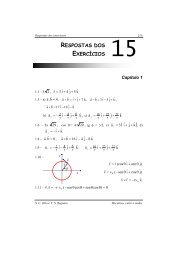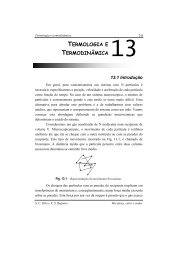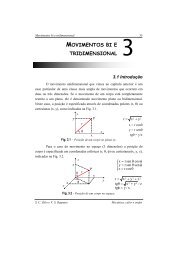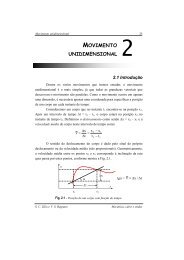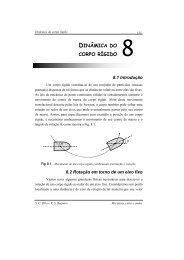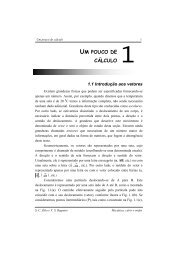Óptica Moderna Fundamentos e aplicações - Fotonica.ifsc.usp.br ...
Óptica Moderna Fundamentos e aplicações - Fotonica.ifsc.usp.br ...
Óptica Moderna Fundamentos e aplicações - Fotonica.ifsc.usp.br ...
You also want an ePaper? Increase the reach of your titles
YUMPU automatically turns print PDFs into web optimized ePapers that Google loves.
A polarização da onda eletromagnética 99<<strong>br</strong> />
y E<<strong>br</strong> />
θ<<strong>br</strong> />
y<<strong>br</strong> />
θ’<<strong>br</strong> />
r k' r<<strong>br</strong> />
H r k r<<strong>br</strong> />
E' r<<strong>br</strong> />
H' r<<strong>br</strong> />
E<<strong>br</strong> />
θ θ’<<strong>br</strong> />
r<<strong>br</strong> />
H<<strong>br</strong> />
r<<strong>br</strong> />
k'<<strong>br</strong> />
r k r<<strong>br</strong> />
E' r<<strong>br</strong> />
H' r<<strong>br</strong> />
E" r<<strong>br</strong> />
θ”<<strong>br</strong> />
(a)<<strong>br</strong> />
k" (b)<<strong>br</strong> />
r<<strong>br</strong> />
H" r<<strong>br</strong> />
n1 x<<strong>br</strong> />
n2<<strong>br</strong> />
θ”<<strong>br</strong> />
H" r<<strong>br</strong> />
Fig. 5.14 - Reflexão e refração de uma onda (a) TE (polarização s) e (b) TM<<strong>br</strong> />
(polarização p). O círculo aberto significa que o campo está saindo<<strong>br</strong> />
do plano e a cruz que ele está entrando no plano.<<strong>br</strong> />
Caso b) TM<<strong>br</strong> />
E" r<<strong>br</strong> />
k" r<<strong>br</strong> />
H - H’= H” (5.26a)<<strong>br</strong> />
E cos θ + E′<<strong>br</strong> />
cos θ = E′<<strong>br</strong> />
′ cos θ ′<<strong>br</strong> />
(5.26b)<<strong>br</strong> />
Novamente, usando a eq. (5.11) para eliminar H em função de E,<<strong>br</strong> />
obtemos: k(<<strong>br</strong> />
E - E′<<strong>br</strong> />
) = k′<<strong>br</strong> />
′ E′<<strong>br</strong> />
′ , de onde sai:<<strong>br</strong> />
τ π<<strong>br</strong> />
ρ π<<strong>br</strong> />
E′<<strong>br</strong> />
′<<strong>br</strong> />
= =<<strong>br</strong> />
E n<<strong>br</strong> />
2<<strong>br</strong> />
2n1<<strong>br</strong> />
cosθ<<strong>br</strong> />
cosθ<<strong>br</strong> />
+ n cos<<strong>br</strong> />
1<<strong>br</strong> />
θ ′<<strong>br</strong> />
E′<<strong>br</strong> />
− n<<strong>br</strong> />
θ ′<<strong>br</strong> />
2 cosθ<<strong>br</strong> />
+ n1<<strong>br</strong> />
cos<<strong>br</strong> />
= =<<strong>br</strong> />
E n cosθ<<strong>br</strong> />
+ n cosθ<<strong>br</strong> />
′<<strong>br</strong> />
2<<strong>br</strong> />
1<<strong>br</strong> />
(5.27a)<<strong>br</strong> />
(5.27b)<<strong>br</strong> />
As equações acima podem ser modificadas usando-se a lei de<<strong>br</strong> />
2 2 2<<strong>br</strong> />
Snell para cos θ " = 1−<<strong>br</strong> />
sen θ"<<strong>br</strong> />
= 1−<<strong>br</strong> />
( n1<<strong>br</strong> />
n 2 ) sen θ , e o índice de<<strong>br</strong> />
refração relativo (n = n2/n1):<<strong>br</strong> />
ρ σ<<strong>br</strong> />
cos θ −<<strong>br</strong> />
=<<strong>br</strong> />
cos θ +<<strong>br</strong> />
n<<strong>br</strong> />
n<<strong>br</strong> />
2<<strong>br</strong> />
2<<strong>br</strong> />
2<<strong>br</strong> />
− sen θ<<strong>br</strong> />
2<<strong>br</strong> />
− sen θ<<strong>br</strong> />
(5.28a)<<strong>br</strong> />
S. C. Zilio <strong>Óptica</strong> <strong>Moderna</strong> – <strong>Fundamentos</strong> e Aplicações




![Curso-Escola-JAS1.ppt [Modo de Compatibilidade] - Fotonica.ifsc ...](https://img.yumpu.com/21076978/1/190x135/curso-escola-jas1ppt-modo-de-compatibilidade-fotonicaifsc-.jpg?quality=85)
